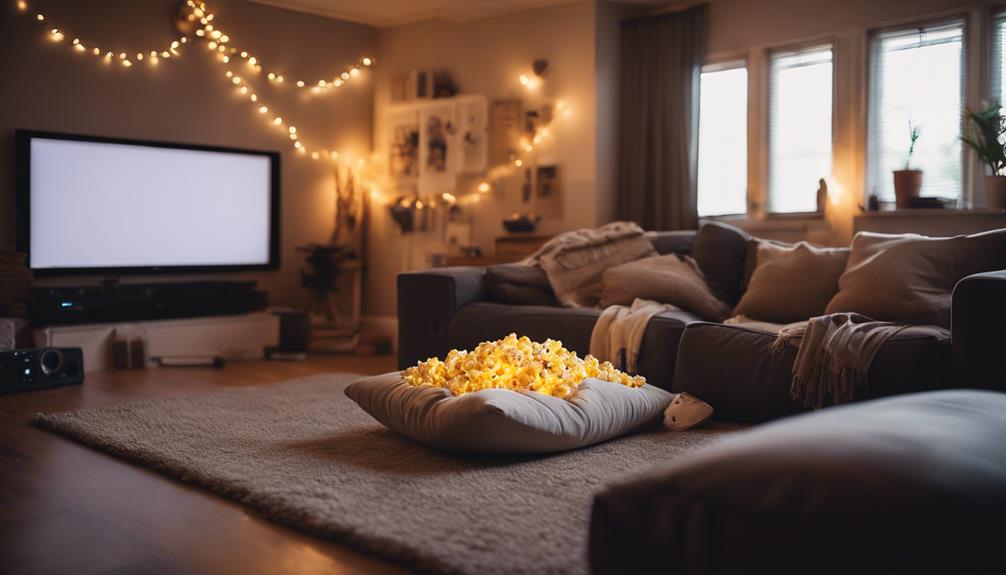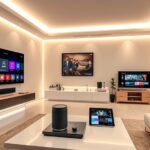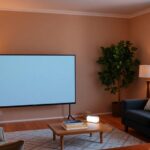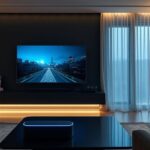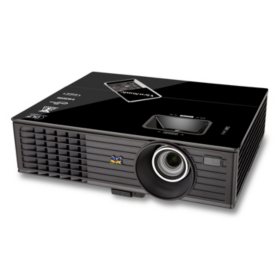Integrating smart home technology into your home cinema elevates your viewing experience with unmatched convenience. You can control devices with a single app or with your voice, reducing the hassle of multiple remotes. Smart lighting adjusts automatically to set the perfect scene, while high-quality audio and video equipment guarantees immersive entertainment. Plus, automated features like smart shades and multi-room audio create a seamless atmosphere for movie nights. By choosing compatible devices and optimizing your setup, you'll enhance both comfort and enjoyment. Want to uncover more tips for creating the ultimate cinematic experience at home?
Key Takeaways
- Smart home integration allows control of all home cinema devices through one interface or voice commands, enhancing convenience.
- Automated lighting systems create ideal viewing conditions by adjusting brightness when movies start, improving the overall experience.
- Voice assistants enable hands-free management of home theater systems, simplifying device control and enhancing accessibility.
- Multi-room audio systems provide seamless sound throughout the home, creating a cohesive atmosphere for movie nights and events.
Benefits of Smart Home Integration
Smart home integration offers you unparalleled convenience by letting you control your home cinema's lighting, audio, and video devices from one simple interface or with just your voice.
With a smart home automation system, you can easily manage your entire home theater setup, transforming it into an immersive experience. Imagine dimming the lights and adjusting the sound with a simple voice command, thanks to smart speakers and automated lighting.
This level of voice control simplifies your multimedia experience, allowing you to focus on enjoying your favorite films rather than fumbling with multiple remotes. You can customize your smart lighting to match the mood of any movie, enhancing the atmosphere for family movie nights or solo viewings.
Additionally, integrating streaming devices into your setup enables seamless access to a wide array of content, all controllable from a single app. The automation of these systems not only provides comfort but can also add value to your property, making it appealing to future buyers seeking modern conveniences in entertainment.
Essential Components for Home Theater
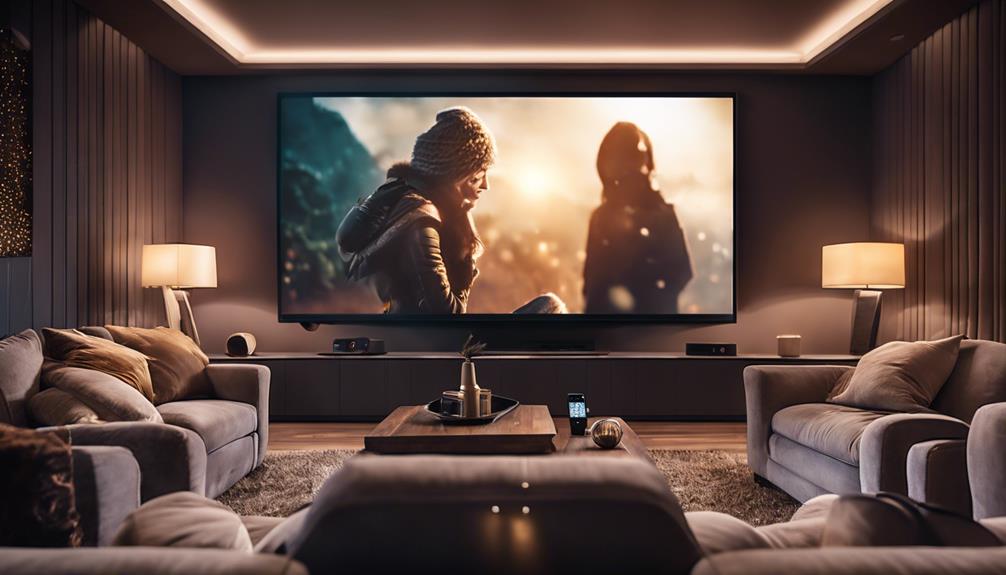
Creating an exceptional home theater requires careful selection of essential components that work seamlessly together to elevate your viewing experience. To build your smart home theater, focus on these key elements:
- Audio Systems: Invest in high-quality audio systems, including surround sound speakers or soundbars, to guarantee peak sound reproduction. Consider incorporating a <a target="_blank" href="https://1hometheatreprojector.com">best headphone amplifier</a> to boost audio quality even further, enhancing your overall cinematic experience.
- Video Equipment: Choose advanced video equipment like 4K projectors or TVs with HDR support. This greatly improves picture clarity and resolution, giving you a more immersive viewing experience.
- Ambient Lighting Systems: Install smart ambient lighting systems that allow you to set the mood for movie nights. These systems help reduce glare and improve visual comfort, creating the perfect atmosphere.
- Ergonomic Seating Options: Don't overlook comfortable seating designed for long viewing sessions. Ergonomic seating guarantees that you and your guests can enjoy your home cinema without discomfort.
Smart Home Features and Automation

Integrating smart home features into your home cinema setup not only enhances convenience but also elevates the overall viewing experience. With smart home technology, you can automate your lighting system, allowing for dimmable lights that adjust automatically when a movie starts. This creates the perfect ambiance for your movie-watching experience.
Voice assistants play an essential role in managing your home theater system seamlessly. You can simply use voice commands to adjust the volume, switch inputs, or even control smart projectors without fumbling for a remote.
Additionally, integrating smart shades can greatly improve viewing conditions by reducing glare during daytime screenings, making your cinematic experience even more immersive.
If you love sound, consider a multi-room audio system that allows sound to flow throughout different areas in your home. This guarantees that the cinematic atmosphere isn't limited to just one room.
Plus, with a smartphone app, managing all these devices becomes a breeze. You'll have a user-friendly interface at your fingertips, making your home cinema experience not only smart but also incredibly enjoyable.
Planning and Implementation Strategies
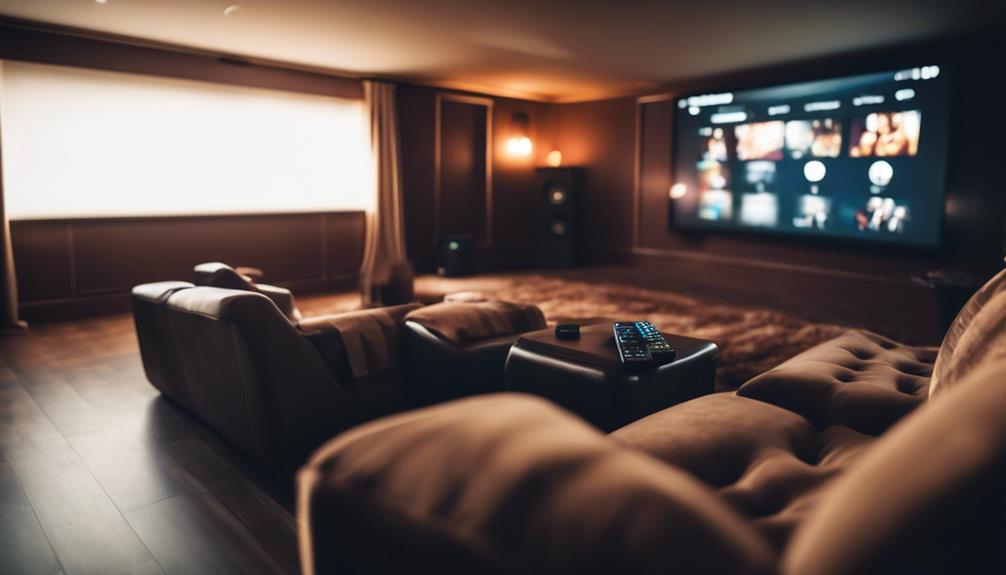
To create an effective smart home cinema, you need to start by evaluating your specific needs and preferences.
Next, research compatible devices that enhance your setup, ensuring they integrate smoothly with your existing hardware.
Assessing Your Needs
How well do your current home entertainment devices align with the latest smart home technology? Evaluating your needs is the first step toward creating a seamless integration for your home theater. Start by reviewing your existing devices and their compatibility with smart technology. This guarantees you maximize your setup's potential.
Consider these key factors:
- Automation Features: Identify which features would enhance your experience, like automated lighting or sound adjustments.
- Device Management: Think about how you want to control your devices. Will you prefer a single remote, a smartphone app, or voice commands?
- Compatible Smart Devices: Research smart projectors, audio systems, and lighting solutions that work harmoniously with your existing setup.
- Budget Planning: Establish a budget that allows for your desired features and future upgrades, ensuring you get the best value from your investment.
Researching Compatible Devices
Exploring the right compatible devices is key to ensuring your home cinema setup works flawlessly with smart home technology.
Start by evaluating the compatibility of your existing devices with potential smart devices. This will help you avoid integration issues down the line. Research specifications and features of smart projectors, sound systems, and lighting controls to enhance your multimedia experience while considering your room dimensions.
Utilize online resources and community forums to gather insights from other users. This can provide valuable information about successful device combinations and common challenges during integration.
Pay attention to user reviews to gauge compatibility with popular smart home systems like Apple HomeKit, Google Home, and Amazon Alexa.
Don't forget to create a detailed list of desired functionalities and evaluate devices based on that. Additionally, consider future scalability when selecting your smart technology.
Choosing compatible products will make upgrades and expansions of your home theater setups much easier over time. Automation becomes seamless when all components work together, enhancing your overall experience.
Designing Optimal Layout
When designing your home cinema layout, start by evaluating the room's dimensions and characteristics to guarantee excellent audio and visual performance. This assessment will help you choose the right screen size, whether it's a smart TV or projector, and facilitate the best speaker placement.
To create an immersive experience, consider these key aspects:
- Ergonomic seating arrangements: Position comfortable seats to maximize sightlines and distances from the screen.
- Ambient lighting systems: Integrate automated lighting that adjusts brightness and color temperature based on the content, creating the perfect movie mode.
- HVAC systems: Evaluate your heating and cooling to maintain an excellent temperature, facilitating comfort during long viewing sessions.
- Seamless control: Plan for compatibility among all devices, allowing for easy integration and future upgrades.
Future Trends in Home Automation
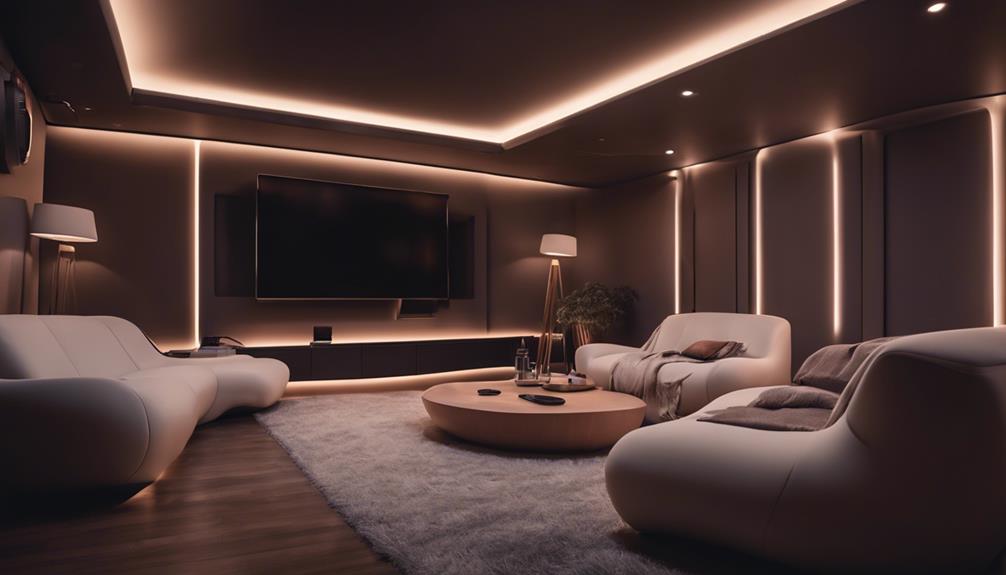
The future of home automation is shaping up to be increasingly interconnected, where devices from different brands will effortlessly collaborate to create a cohesive smart home environment. As you explore these advancements, you'll notice a strong emphasis on compatibility, ensuring all your devices work together seamlessly.
| Trend | Description |
|---|---|
| Artificial Intelligence | AI will personalize your smart home, adapting settings to your habits for enhanced convenience. |
| Energy Efficiency | New technologies will focus on reducing energy consumption through automated settings and real-time monitoring. |
| Security Features | Enhanced security measures, including biometric authentication, will protect your data and privacy. |
Additionally, the integration of virtual reality (VR) and augmented reality (AR) will revolutionize how you interact with your smart home, offering immersive control and visual experiences. As these technologies evolve, you'll see a greater focus on energy efficiency and sustainability, making your smart home not just convenient, but also eco-friendly. Embracing these trends will lead to a more secure and efficient home automation experience, transforming the way you enjoy your living space.
Optimizing Visuals and Audio
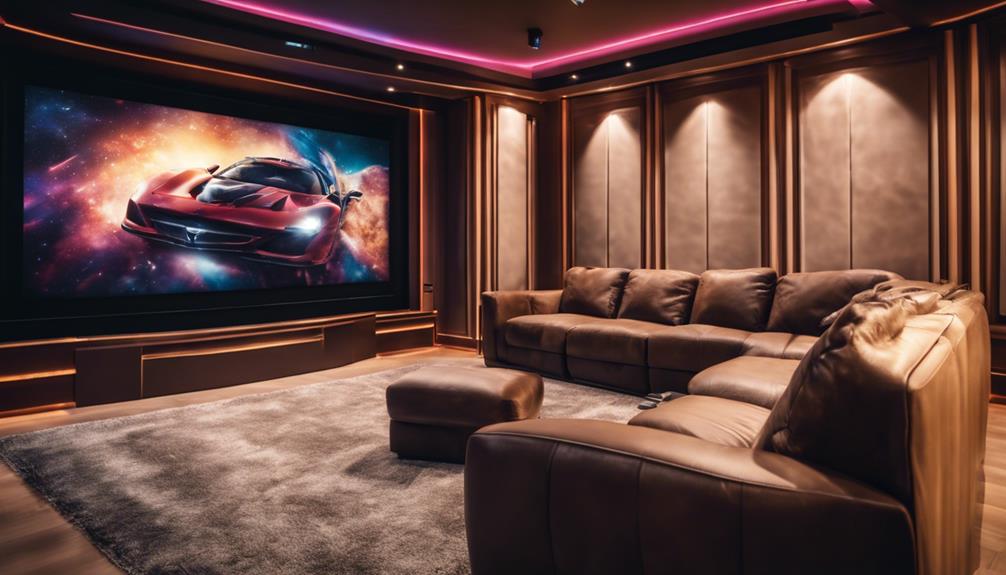
To truly elevate your home cinema experience, you need to focus on smart projector selection and audio system calibration.
Choosing a projector with high brightness and contrast can transform your visuals, while fine-tuning your audio setup guarantees immersive sound that matches the stunning picture quality.
Let's explore how these elements work together to create an enchanting cinematic atmosphere.
Smart Projector Selection
Selecting the right smart projector can transform your home cinema experience by delivering stunning visuals and immersive audio. To make the best choice, keep these key features in mind:
- HDR Support: Look for a smart projector that supports HDR, enhancing color and contrast for a vivid viewing experience.
- High Brightness Ratings: Choose models with high brightness ratings of at least 2,500 lumens. This guarantees picture clarity, even in well-lit rooms.
- Wireless Connectivity: Opt for projectors that offer wireless connectivity for seamless integration with your smart home system, allowing easy streaming from various devices.
- Adjustable Picture Settings: Select projectors with adjustable picture settings and automatic adjustments to optimize image quality based on ambient lighting conditions.
Additionally, consider models that support multiple screen sizes and installation options, including short-throw capabilities. This flexibility allows you to fit your projector into different room dimensions and layouts effectively.
Audio System Calibration
Optimizing your audio system through calibration can greatly enhance your home cinema experience, complementing the stunning visuals delivered by your smart projector. Audio calibration systems automatically adjust sound levels based on your room's unique acoustics, guaranteeing peak audio performance.
Many modern audio systems come with built-in calibration features that analyze sound output and make real-time adjustments, creating an immersive experience. Proper calibration enhances sound clarity, balance, and spatial effects, considerably improving your audio quality for movies and music alike.
Here's a quick overview of audio calibration benefits:
| Benefit | Description | Frequency |
|---|---|---|
| Clarity | Improves dialogue and sound detail | Regular calibration |
| Balance | Guarantees even sound distribution across speakers | After room changes |
| Spatial Effects | Enhances surround sound experience | With new equipment |
| Customization | Allows for tailored audio profiles | As preferences change |
| Consistency | Maintains sound quality over time | Every 6 months |
Smart Lighting and Ambiance Control
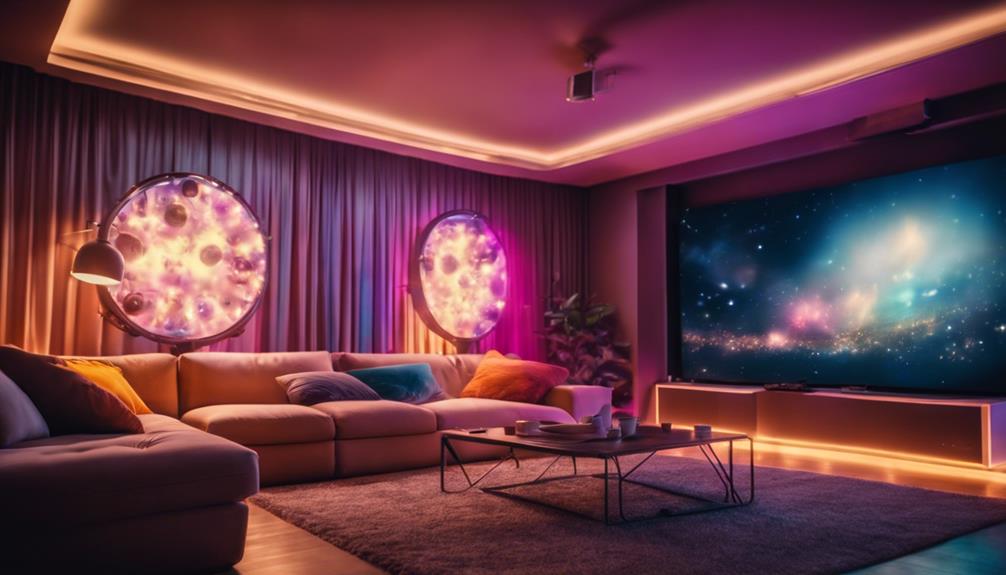
Smart lighting systems transform your home cinema experience by automatically adjusting brightness and color temperature to create the ideal ambiance for movie nights. With the right setup, you can enjoy a theater-like atmosphere without lifting a finger.
Here's how smart lighting enhances your viewing experience:
- Automated Lighting Scenes: Create specific scenes for activities like movie mode or gaming with a single command.
- Dimmable Smart Lights: Set your lights to lower automatically when a film starts, ensuring an ideal ambiance.
- Voice-Controlled Lighting: Use voice commands to make hands-free adjustments, making shifts between different activities seamless.
- Smart Shades Integration: Control natural light to reduce glare on screens during daytime screenings, enhancing visibility.
Home Theater Management Systems
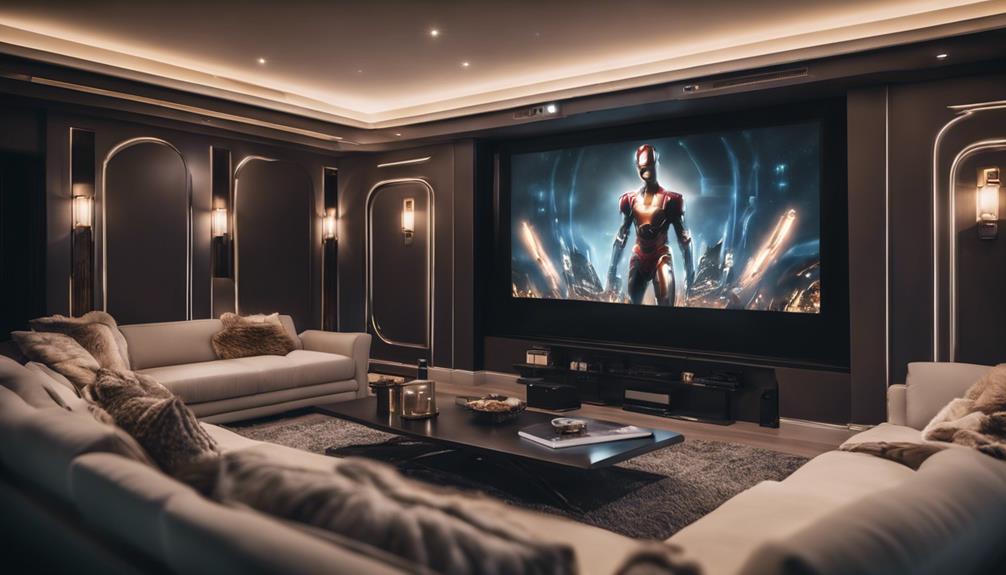
Home theater management systems streamline your viewing experience by allowing you to control all your devices from one convenient interface. Imagine effortlessly managing your projectors, sound systems, and lighting without juggling multiple remotes. With these systems, you can easily access your favorite streaming services and enjoy a seamless cinema experience.
Many home theater management systems come with smartphone and tablet controls, letting you adjust settings from anywhere in your house.
Plus, integrating voice commands through a virtual assistant like Google Assistant or Amazon Alexa makes operation even simpler; just speak your commands and watch your home theater respond.
You can also create automated scenes tailored to your preferences. For instance, a "cinema mode" can adjust the lighting, sound, and device settings with one command, transforming your space into a perfect viewing environment. This level of automation not only enhances your enjoyment but also brings a touch of luxury to your smart home.
Incorporating a home theater management system elevates your movie nights and makes entertainment truly effortless. Embrace the convenience and enjoy every moment of your cinematic adventures.
Comprehensive Home Theater Automation
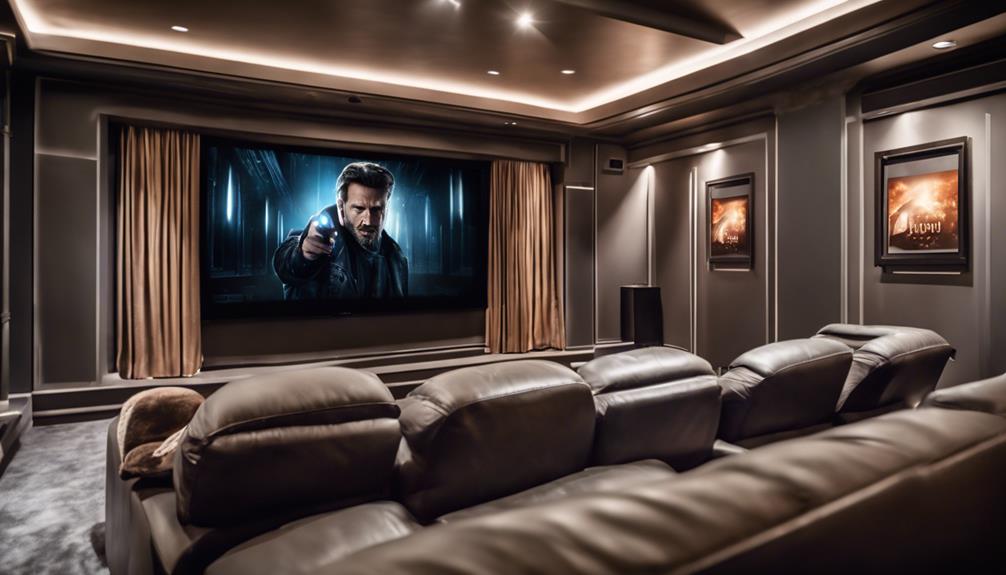
Thorough home theater automation transforms your viewing experience by seamlessly integrating projectors, sound systems, and lighting to match your preferences. With extensive home theater automation, you can create an immersive cinematic experience that feels tailor-made for you.
Here's how you can enhance your setup:
- Automated Lighting Scenes: Program your lights to adjust automatically when movie mode is activated, guaranteeing the perfect ambiance.
- Multi-Device Control: Use a single hub or app to manage all components, reducing clutter and simplifying interactions.
- Voice-Activated Controls: Enjoy hands-free operation by using voice commands to adjust settings or switch between activities without dealing with multiple remotes.
- Regular Software Updates: Keep your system running smoothly and guarantee compatibility with the latest smart home technology advancements.
Enhancing Security in Home Cinemas
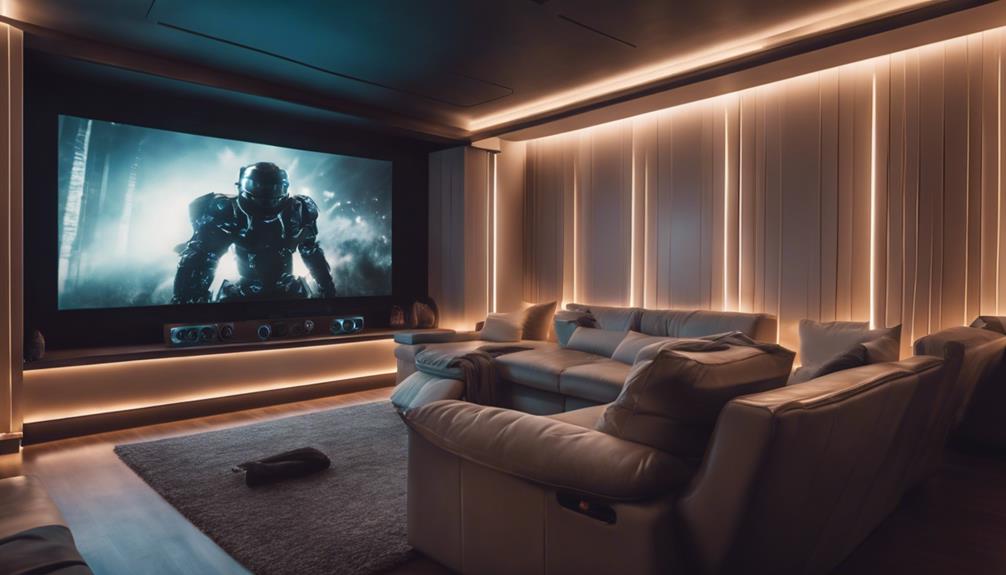
To enhance security in your home cinema, consider integrating smart locks and remote monitoring solutions.
With keyless entry, you can control who accesses your space, while security cameras provide real-time oversight.
These measures not only protect your equipment but also guarantee a safe environment for your viewing experience.
Smart Locks Integration
Enhancing security in your home cinema is easily achieved with smart locks that provide keyless entry and remote access for authorized users.
These locks not only boost security but also offer incredible convenience and automation. Here are some key benefits of integrating smart locks into your home cinema:
- Keyless Entry: Eliminate the hassle of physical keys. Grant access through mobile apps or temporary access codes for guests.
- Voice Control: Use voice commands via Amazon Alexa or Google Assistant to lock or secure your cinema door, making it even easier to protect your space.
- Integration with Smart Home Systems: Smart locks can work alongside security cameras and alarms, providing real-time alerts if unauthorized access is attempted.
- Automatic Locking: Customize your smart lock to automatically secure the cinema after a designated time, ensuring your space is protected after movie nights or gatherings.
Remote Monitoring Solutions
Remote monitoring solutions empower you to keep a vigilant eye on your home cinema, ensuring a secure environment while you enjoy your favorite films.
With smart security cameras, you can receive real-time alerts and access live feeds directly from your smartphone, allowing you to monitor your cinema from anywhere. This convenience means you'll always know what's happening, even if you're miles away.
Integrating smart locks with your remote monitoring system enhances security further. You can control access to your cinema without needing physical keys, making it easier to keep unwanted visitors out.
Advanced motion detection capabilities in these smart cameras provide notifications of any unusual activity, giving you peace of mind during your movie nights.
Additionally, many remote monitoring solutions offer cloud storage for video footage. This feature allows you to review past events, enhancing your security awareness and helping you make informed decisions about your home cinema setup.
Frequently Asked Questions
What Is Home Theater Automation?
Home theater automation means integrating devices like projectors, sound systems, and lighting, so you can control everything effortlessly. It creates immersive experiences by allowing you to adjust settings with just one command or tap on your phone.
What Is a Smart Home Integration?
Smart home integration is when you connect various devices in your home, allowing them to communicate and be controlled from one interface. It enhances convenience, energy efficiency, and security, making your daily life easier and more efficient.
What Is an Example of Smart Home Automation?
An example of smart home automation is setting your lights to dim and your curtains to close with one command. You can create specific moods for different activities, enhancing your home's atmosphere effortlessly.
How Does Smart Home Automation Work?
Smart home automation works by connecting devices through a centralized hub, letting you control everything remotely. You can set schedules, use voice commands, and create scenes to enhance your living environment effortlessly and efficiently.
Conclusion
As you explore the world of smart home integration for your home cinema, imagine transforming your viewing experience into something extraordinary.
Envision this: with just a voice command or a tap on your phone, the lights dim, the curtains draw, and your favorite movie starts.
You're not just watching a film; you're immersed in a cinematic adventure.
So, are you ready to take the plunge and elevate your home theater to new heights?
The magic awaits!

